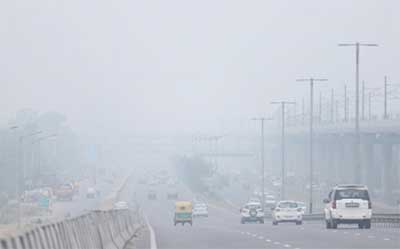Causes of alarming air pollution in Delhi include:
- City’s landlocked geographical location.
- Stubble burning in neighbouring states (Punjab, Haryana and Rajasthan).
- Vehicular emissions
- Industrial pollution
- Large-scale construction activities
Major Measures Taken:
- 10-point winter action plan that focuses on dust control using the PUSA bio decomposer, checking waste burning etc.
- Installation of anti-smog guns at major construction sites.
- Potential banning of construction, however this ban has been lifted now.
- BS VI Norms to tackle vehicular pollution.
- National Clean Air Programme to decrease PM 2.5 and PM 10 by 2024
- Smog towers are being installed in Delhi. The IITs are studying the tower to monitor its effectiveness, which involves measuring pollution levels at various distances from the tower.
Air pollution in India
- The air pollution levels in India are among the highest in the world, posing a heavy threat to the country's health and economy.
- The Government of India’s National Clean Air Programme (NCAP) is a powerful step in acknowledging and resolving the problem of deteriorating ambient air quality.
- A strong emphasis on expanding renewable energy, promoting electric vehicles, and supplying LPG cooking fuel to millions of households are some examples of the actions India is taking to combat air pollution.
- In 2020, based on the recommendations of the 15th Finance Commission, the Government of India has set aside about $1.7 billion to fight air pollution over the next five years,
- Air (Prevention and Control of Pollution) Act, 1981
- The Central Pollution Control Board is constituted under the Water Pollution Act which monitors the air quality.
- National Air Quality Monitoring Program initiated in 1984 by CPCB to determine air quality.
- National Ambient Air Quality standards were notified by CPCB under the Air Act, 1981. This includes 12 pollutants- PM2.5, PM10, NOx etc.
- National Air Quality index launched in 2015 gives the weighted average of pollutants which is reflected through colour codes. The 8 pollutants include-PM2.5, PM10, NOx, SOx, ozone, CO, lead and ammonia
- Real time monitoring of air quality through SAFAR
System of Air Quality and Weather Forecasting And Research
- SAFAR is a national initiative introduced by the Ministry of Earth Sciences (MoES) to measure the air quality of a metropolitan city, by measuring the overall pollution level and the location-specific air quality of the city.
- The system is indigenously developed by the Indian Institute of Tropical Meteorology (IITM), Pune and is operationalized by the India Meteorological Department (IMD).
- The objective of the project is to increase awareness among the general public regarding the air quality in their city so that appropriate mitigation measures and systematic action can be taken up.
- It monitors all weather parameters like temperature, rainfall, humidity, wind speed, and wind direction, UV radiation, and solar radiation.
- Pollutants Monitored: PM2.5, PM10, Ozone, Carbon Monoxide (CO), Nitrogen Oxides (NOx), Sulfur Dioxide (SO2), Benzene, Toluene, Xylene, and Mercury.
Way forward
- The focus should be on more greener fuels sustainable energy and cutting down the pollutants right at the source
- Right to clean environment is a fundamental right under Art 21 of the Constitution
- It is everyone's duty to provide clean and safe environment to the future generations under Fundamental Duties Art 51A(g)
- It is a shared responsibility of the State and citizens
Related terms: Local surface wind, AQI, SAFAR
Source:







